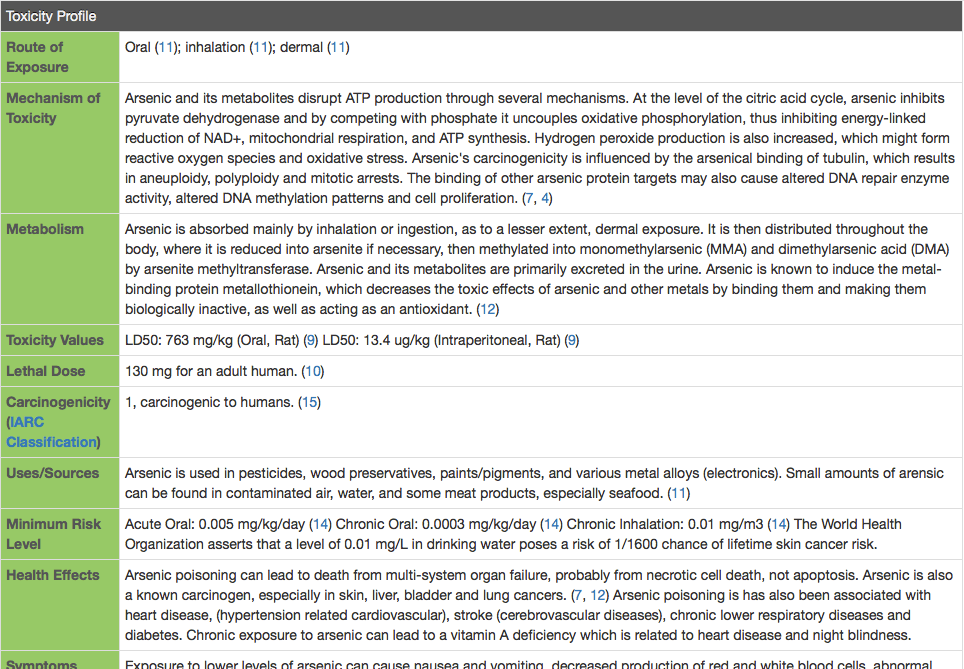T3DB on:
[Wikipedia]
[Google]
[Amazon]
The Toxin and Toxin-Target Database (T3DB), also known as the Toxic
sources
which includ
other databases
government documents, books, and scientific literature. The primary focus of the T3DB is on providing mechanisms of toxicity and identifying target proteins for common toxic substances. While a number of other toxic compound databases do exist, their emphasis is on covering large numbers of chemical compounds that are almost never seen outside a chemical laboratory. T3DB attempts to capture data on only those toxic substances that are abundant or in widespread use and have been detected or measured in humans. T3DB is fully searchable and supports extensive text, sequence, chemical structure, relational query and spectral searches. It is both modelled after and closely linked to the
Exposome
An environmental factor, ecological factor or eco factor is any factor, abiotic or biotic, that influences living organisms. Abiotic factors include ambient temperature, amount of sunlight, and pH of the water soil in which an organism lives. Bi ...
Database, is a freely accessible online database of common substances that are toxic to humans, along with their protein, DNA or organ targets. The database currently houses nearly 3,700 toxic compounds or poisons described by nearly 42,000 synonyms. This list includes various groups of toxins
A toxin is a naturally occurring organic poison produced by metabolic activities of living cells or organisms. Toxins occur especially as a protein or conjugated protein. The term toxin was first used by organic chemist Ludwig Brieger (1849–1 ...
, including common pollutants, pesticides
Pesticides are substances that are meant to control pests. This includes herbicide, insecticide, nematicide, molluscicide, piscicide, avicide, rodenticide, bactericide, insect repellent, animal repellent, microbicide, fungicide, and lampric ...
, drugs
A drug is any chemical substance that causes a change in an organism's physiology or psychology when consumed. Drugs are typically distinguished from food and substances that provide nutritional support. Consumption of drugs can be via inhalat ...
, food toxins, household and industrial/workplace toxins, cigarette toxins, and uremic toxin
Uremia is the term for high levels of urea in the blood. Urea is one of the primary components of urine. It can be defined as an excess of amino acid and protein metabolism end products, such as urea and creatinine, in the blood that would be nor ...
s. These toxic substance
A toxicant is any toxic substance, whether man-made or naturally occurring. By contrast, a toxin is a poison produced naturally by an organism (e.g. plant, animal, insect). The different types of toxicants can be found in the air, soil, water, or ...
s are linked to 2,086 corresponding protein/DNA target records. In total there are 42,433 toxic substance-toxin target associations. Each toxic compound record (ToxCard) in T3DB contains nearly 100 data fields and holds information such as chemical properties and descriptors, mechanisms of action, toxicity or lethal dose values, molecular and cellular interactions, medical (symptom and treatment) information (Fig. 1–3), NMR an MS spectra, and up- and down-regulated genes. This information has been extracted from over 18,00sources
which includ
other databases
government documents, books, and scientific literature. The primary focus of the T3DB is on providing mechanisms of toxicity and identifying target proteins for common toxic substances. While a number of other toxic compound databases do exist, their emphasis is on covering large numbers of chemical compounds that are almost never seen outside a chemical laboratory. T3DB attempts to capture data on only those toxic substances that are abundant or in widespread use and have been detected or measured in humans. T3DB is fully searchable and supports extensive text, sequence, chemical structure, relational query and spectral searches. It is both modelled after and closely linked to the
Human Metabolome Database
The Human Metabolome Database (HMDB) is a comprehensive, high-quality, freely accessible, online database of small molecule metabolites found in the human body. Created by the Human Metabolome Project funded by Genome Canada. One of the first d ...
( HMDB) and DrugBank. Potential applications of T3DB include metabolomics and environmental exposure studies, toxic compound metabolism prediction, toxin/drug interaction prediction, and general toxic substance awareness.

Scope and access
All data in T3DB is non-proprietary or is derived from a non-proprietary source. It is freely accessible and available to anyone. In addition, nearly every data item is fully traceable and explicitly referenced to the original source. T3DB data is available through a public web interface and downloads.See also
*Poison
Poison is a chemical substance that has a detrimental effect to life. The term is used in a wide range of scientific fields and industries, where it is often specifically defined. It may also be applied colloquially or figuratively, with a broa ...
* Toxin
* List of extremely hazardous substances
*List of biological databases
Biological databases are stores of biological information. The journal ''Nucleic Acids Research'' regularly publishes special issues on biological databases and has a list of such databases. The 2018 issue has a list of about 180 such databases an ...
* KEGG
* HMDB
* SMPDB
References
{{reflist, refs= {{cite journal , title=T3DB: the toxic exposome database., author1-link=David S. Wishart, last=Wishart, first=D, author2=Arndt D, author3=Pon A, author4=Sajed T, author5=Guo AC, author6=Djoumbou Y, author7=Knox C, author8=Wilson M, author9=Liang Y, author10=Grant J, author11=Liu Y, author12=Goldansaz SA, author13=Rappaport SM. , journal=Nucleic Acids Research, date=Jan 2015, volume=43, issue=Database issue, pages=D928-34, doi=10.1093/nar/gku1004, pmid=25378312, pmc=4383875 {{cite journal , title=T3DB: a comprehensively annotated database of common toxins and their targets., last=Lim, first=E, author2=Pon A , author3=Djoumbou Y , author4=Knox C , author5=Shrivastava S , author6=Guo AC , author7=Neveu V , author8=Wishart DS. , journal=Nucleic Acids Research, date=Jan 2010, volume=38, issue=Database issue, pages=D781-6, doi=10.1093/nar/gkp934, pmid=19897546, pmc=2808899 Metabolomic databases Chemical databases Biological databases